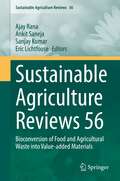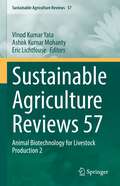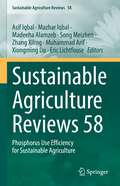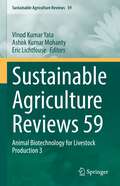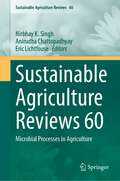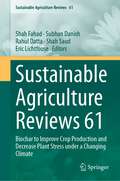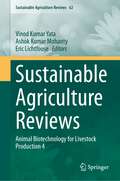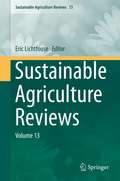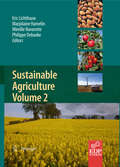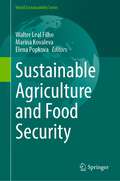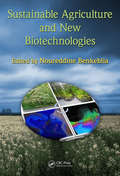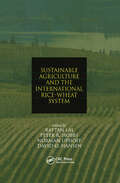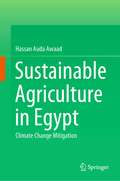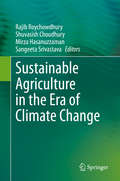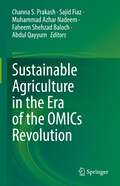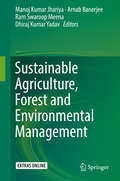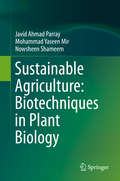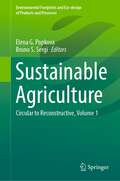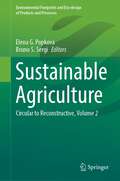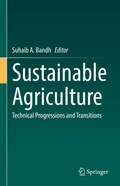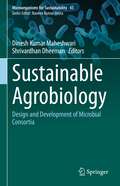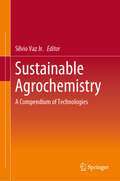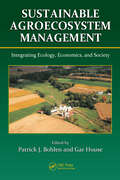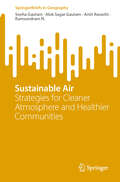- Table View
- List View
Sustainable Agriculture Reviews 56: Bioconversion of Food and Agricultural Waste into Value-added Materials (Sustainable Agriculture Reviews #56)
by Eric Lichtfouse Sanjay Kumar Ankit Saneja Ajay RanaThis book reviews the sources, extraction, processing and applications of value-added compounds from agro-waste, with a focus on drug delivery, tea, apple pomace, lignin nanocomposites, bioethanol, fertilizers and sitosterol. Food residues provide bioactive molecules, enzymes, vitamins, antioxidants, and animal feed.
Sustainable Agriculture Reviews 57: Animal Biotechnology for Livestock Production 2 (Sustainable Agriculture Reviews #57)
by Ashok Kumar Mohanty Eric Lichtfouse Vinod Kumar YataThis 2nd book provides fundamental concepts and recent applications of biotechnological methods, such as genetic selection, breeding methods and genetic engineering tools. Biotechnology has remarkably improved the productivity of livestock by increasing the reproduction efficiency and decreasing the generation time. The chapters detail the mechanisms of methods for animal reproduction and breeding methods. This book focus on the impact of minerals, steroids metabolic stress, nutritional stress and anti-nutritional factors on the livestock reproduction.
Sustainable Agriculture Reviews 58: Phosphorus Use Efficiency for Sustainable Agriculture (Sustainable Agriculture Reviews #58)
by Eric Lichtfouse Muhammad Arif Asif Iqbal Mazhar Iqbal Madeeha Alamzeb Song Meizhen Zhang Xiling Xiongming DuThis book presents recently-developed crop, soil, and management practices that can be used to improve phosphorous use efficiency in agriculture. Food security highly depends on the availability of plant nutrients such as phosphorus, yet rock phosphate reserves are expected to be exhausted in the next 50–100 years. Moreover, about 80% of the phosphorous fertilizers applied to soils become unavailable to plants due to phosphorous fixation in iron and aluminum oxides in acidic soils and with carbonates in alkaline soils. As a consequence, only 10-15% of applied phosphorous is up taken by crops. Therefore, there is a need for advanced practices for improving phosphorus use efficiency.
Sustainable Agriculture Reviews 59: Animal Biotechnology for Livestock Production 3 (Sustainable Agriculture Reviews #59)
by Ashok Kumar Mohanty Eric Lichtfouse Vinod Kumar YataThe dependency on animal biotechnology in livestock industries has been increased in the recent past. The livestock production research has witnessed remarkable developments on biotechnological methods to produce the elite animal breeds. The global animal food requirement has been steadily increasing, and animal production needs to be increased as per the global needs. This book covers various aspects of animal biotechnology such as, reproductive biotechnologies in sheep and goats, oogenesis and folliculogenesis and ovarian disorders. This book focusses the discussion on proteomics and metabolomics, and separate chapters were dedicated to discuss these topics. The proteomics studies of animal viruses were discussed in this book, and this would be helpful to understand animal viral pathogenesis. The applications of metabolomics in livestock were discussed with focus on data analysis, identification of unknown compounds. The purpose of this book is to provide the recent research trends, and convert all this information to usable guide to professionals, researchers and students who are working the research area of animal biotechnology.
Sustainable Agriculture Reviews 60: Microbial Processes in Agriculture (Sustainable Agriculture Reviews #60)
by Eric Lichtfouse Nirbhay K. Singh Anirudha ChattopadhyayIn the context of rising adverse effects of climate change on agriculture, there is a need for advanced methods and practices to manage soils for production of food and energy. This book presents the latest advances in microbial processes that control plant growth, with focus on genomic tools, microbial interactions with the plant and soils habitats, mobilization of plant nutrients, agricultural waste management, biodegradation, bioremediation, carbon sequestration, land reclamation, plant growth promotion, suppression of plant pathogens, induced systemic resistance and tolerance against biotic and abiotic stresses.
Sustainable Agriculture Reviews 61: Biochar to Improve Crop Production and Decrease Plant Stress under a Changing Climate (Sustainable Agriculture Reviews #61)
by Eric Lichtfouse Rahul Datta Shah Fahad Shah Saud Subhan DanishThe book aim to contribute the latest understandings of physiological, biochemical and molecular bases of the responses of major crop plants to a range of different biomass produced biochar to introduce climate resilience crop varieties which leads to enhanced crop productivity and quality under stressful conditions and also for better utilization of natural resources to ensure food security through modern breeding. Finally, this book will be a valuable resource for future plant stress related research with biochar, and can be considered as a reference book for front-line researchers working on sustaining crop production under climate change.Adverse effects of climate changes on crops has developed the situation quite critical for sustainable agriculture. Food security has become in danger due to low production of agricultural crops by resilient climate and ever increasing human population. Heat, drought, salinity, soil compaction, flooding and poor soil organic carbon induced stress in crops by climate adverse conditions are major concerns in this regard. A mechanistic understanding of the interactions between abiotic stresses response of crops is needed to identify and take advantage of acclimation traits in major crop species as a prerequisite for securing robust yield and good quality. This underpins a need for crops with inherent yield increase, yield stability against multiple abiotic stresses and improved quality. Individual stress tolerance mechanisms have been well documented so far. However, mechanisms behind plants’ tolerance by application of biochar and its interactions with soil and plant roots towards multiple abiotic stresses are not fully understood. In addition, there will always be some uncertainty associated with modelling the complex relationships between agricultural yields, product quality with biochar under future climate scenarios. Prediction of yield and quality stability, one of most complex agronomic traits, must integrate aspects of plant development, physiology, biochemistry and genetics. Furthermore, the GxExM interactions will complicate the model predications, thus the responses of a given genotype to a defined environment under certain management strategy need to be determined empirically and used to parameterise and refine crop models.
Sustainable Agriculture Reviews: Animal Biotechnology for Livestock Production 4 (Sustainable Agriculture Reviews #62)
by Ashok Kumar Mohanty Eric Lichtfouse Vinod Kumar YataThis book presents advanced reviews on latest developments and future trends of animal biotechnology with focus on computational and experimental approaches. The articles in this book discusses the implications of recent methods in animal biotechnology to improve the livestock production. Applications of omics technologies and system biology approaches for livestock production and animal disorders were discussed in detail. The evolution of transgenic technology, genome editing and markers for early pregnancy detection were elucidated in this book. A couple of chapters were dedicated to understanding the role of gut microbiome, probiotics and prebiotics on livestock health and production. The nanomaterials have been shown been shown beneficial effects in biological applications. This book also discussed the veterinary applications of nanomaterials. The articles of this book provide state of the art information that is appropriate to academicians, researchers and students who are involved in the animal biotechnology research.
Sustainable Agriculture Reviews: Volume 13
by Eric LichtfouseSustainable agriculture is a rapidly growing field aiming at producing food and energy in a sustainable way for humans and their children. It is a discipline that addresses current issues: climate change, increasing food and fuel prices, poor-nation starvation, rich-nation obesity, water pollution, soil erosion, fertility loss, pest control and biodiversity depletion. This series gathers review articles that analyze current agricultural issues and knowledge, then proposes alternative solutions.
Sustainable Agriculture Volume 2
by Eric Lichtfouse Marjolaine Hamelin Mireille Navarrete Philippe DebaekeThis book gathers review articles that analyze current agricultural issues and knowledge, then propose alternative solutions. It will therefore help all scientists, decision-makers, professors, farmers and politicians who wish to build a safe agriculture, energy and food system for future generations.
Sustainable Agriculture and Agribusiness in Iran (Perspectives on Development in the Middle East and North Africa (MENA) Region)
by Masoomeh RashidghalamThis book presents a collection of ten empirical studies on Iran’s sustainable agriculture and agribusiness, grouped into three domains: agricultural prices and commodity market analysis; risk management and climate change; and natural resources and environmental economics. The various studies elaborate on sustainable agriculture, climate change, pest management, natural resources, land-use, agricultural marketing, risk management and insurance in Iran’s agricultural sector. The book also introduces the key microeconomic principles that are applied to agriculture from a suitability perspective, and provides policy recommendation to decision makers and agricultural-product producers. As such it serves as a supplement to textbooks on applied economics, agricultural and environmental economics, and offers students and professionals in agricultural economics, resource economics, risk management, and food policy as well as general economists real-world examples of the principles under discussion. Further, it includes an extensive range of case studies from different regions of the country, which could be applied in agricultural policy making process, making it a useful resource for agricultural planners and decision makers in government agencies.
Sustainable Agriculture and Food Security (World Sustainability Series)
by Walter Leal Filho Marina Kovaleva Elena PopkovaThis book describes initiatives and concrete examples on sustainable food production worldwide. In the current world scenario, where nations all over the world are struggling to accomplish the United Nations Sustainable Development Goals and to ensure sustainable patterns for all, this book provides a contribution towards a more comprehensive and interdisciplinary understanding of the cross-cutting issues related to Sustainable Agriculture and Food Security. This interdisciplinary book supports the efforts to engage a commitment from all fields of science, to work together to provide knowledge that could help to address SDG2 (No hunger) and lead to the promotion of quality of life, by means of a more sustainable food production, and improved food security. This book is expected to fill the gap of publications in this field. It gives a special emphasis to a state-of-the-art descriptions of approaches, methods, initiatives and projects from universities, stakeholders, organizations and civil society across the world, regarding cross-cutting issues in sustainable food production. It includes examples of policies and practices case studies, examples of projects, institutional policies, innovative methods and tools and research outputs, which highlight the interdependence between sustainable agriculture and food security issues. It is expected that the “Sustainable Agriculture and Food Security” will make the many benefits of sustainable food production clearer and, inter alia, lead to an increase in the emphasis provided to this central theme.
Sustainable Agriculture and New Biotechnologies
by Noureddine BenkebliaTaking a broad and innovative informational approach, Sustainable Agriculture and New Biotechnologies is the first book to apply omic technologies to address issues related to understanding and improving agricultural sustainability in the food production process. The transformation from industrial to sustainable agriculture is discussed within the
Sustainable Agriculture and the International Rice-Wheat System (Books In Soils, Plants, And The Environment Ser. #Vol. 103)
by Rattan Lal David O. Hansen Peter R. Hobbs Norman UphoffAddressing a topic of major importance to the maintenance of world food supplies, this reference identifies knowledge gaps, defines priorities, and formulates recommendations for the improvement of the rice-wheat farming system. The book reveals new systems of rice intensification and management and illustrates the application of no-till and conser
Sustainable Agriculture in Egypt: Climate Change Mitigation
by Hassan Auda AwaadThis book consists of 10 Chapters in 4 Parts. The first Part is an introduction and contains Chapter 1 to introduce the book chapters to the audiences. The second Part consists of two chapters under the name, Impact of Climate Change on Crop Production and the Physiological and Biochemical Basis for Crops Tolerance. The Chapter 2 focus on critical periods of crop plants to stress conditions and the expected impacts of climate changes mainly on the productivity and quality of field crops. While, Chapter 3 highlights the foundations of crop tolerance to environmental stress and plant traits relevant to stress tolerance. It is devoted to explain and discuss mechanisms of adaptation to environmental stress conditions and addresses various plant traits related to stress environmental tolerance i.e. phenological, morpho-physiological and biochemical traits which could be used as selection criteria for crops improvement. The third Part consists of 5 Chapters under the theme “Improve Crop Adaptability and Stability to Climate Change and Modern Technology". Chapter 4 highlights the most important strategic food grain crop (wheat), Chapter 5 focuses the important staple food crop (rice), while Chapter 6 deals with one of the most important food legume crops (faba bean). Chapter 7 and 8 discuss two important oil crops (sesame and sunflower). However, Chapter 9 focuses on cotton as one of the most important fiber crops. The author addresses these crops under the following headings: genotype x environment interaction and its relation to climatic change on yield production, performance of genotypes in response to environmental changes, adaptability and yield stability to environmental conditions, additive main effects and multiplicative interaction model, gene action, genetic behavior and heritability for traits related to environmental stress tolerance, role of recent approaches, biotechnology and nanotechnology. This is besides how can measure sensitivity of genotypes to environmental stress, and finally the appropriate agricultural practices to mitigate environmental stress on crops under attention. The book ends with Chapter No. 10 where the author presents an update of the book topics, present the most important conclusions and recommendations from all chapters.This book has been prepared and supported by recent references and statistics with coloured tables and illustrations for audiences interested in crop science,environment, plant breeding, genetics and biotechnology, as well as postgraduate students and researchers in universities and research centres.
Sustainable Agriculture in the Era of Climate Change
by Sangeeta Srivastava Mirza Hasanuzzaman Rajib Roychowdhury Shuvasish ChoudhuryUnder ongoing climate changes, natural and cultivated habitats of major crops are being continuously disturbed. Such conditions impose and exacerbate abiotic and biotic stressors. Drought, salinity, flood, cold, heat, heavy metals, metalloids, oxidants, irradiation, etc. are important abiotic stressors, while diseases and infections caused by plant pathogens, such as fungal agents, bacteria and viruses, are major biotic stresses. In many instances, stresses have become the major limiting factor for agricultural productivity and exert detrimental role on growth and yield of the crops. To help feed an ever increasing world population and to ensure global food security, concerted efforts from scientists and researchers have identified strategies to manage and mitigate the impacts of climate-induced stresses. This book, summarizing their findings, is aimed at crop improvement beyond such kind of barriers, by agronomic practices (genetics, breeding, phenotyping, etc.) and biotechnological applications, including molecular markers, QTL mapping, genetic engineering, transgenesis, tissue culture, various 'omics' technologies and gene editing. It will cover a wide range of topics under environmental challenges, agronomy and agriculture processes, and biotechnological approaches. Additionally, fundamental mechanisms and applied information on stress responses and tolerance will be discussed. This book highlights problems and offers proper solutions for crop stress management with recent information and up-to-date citations. We believe this book is suitable for scientists, researchers and students working in the fields of agriculture, plant science, environmental biology and biotechnology.
Sustainable Agriculture in the Era of the OMICs Revolution
by Abdul Qayyum Channa S. Prakash Sajid Fiaz Faheem Shehzad Baloch Muhammad Azhar NadeemAccess to food with enough calories and nutrients is a fundamental right of every human. The global population has exceeded 7.8 billion and is expected to pass 10 billion by 2055. Such rapid population increase presents a great challenge for food supply. More grain production is needed to provide basic calories for humans. Thus, it is crucial to produce 60-110% more food to fill the gap between food production and the demand of future generations.Meanwhile food nutritional values are of increasing interest to accommodate industrialized modern lives. The instability of food production caused by global climate change presents another great challenge. The global warming rate has become more rapid in recent decades, with more frequent extreme climate change including higher temperatures, drought, and floods. Our world faces various unprecedented scenarios such as rising temperatures, which causes melting glaciers and the resulting various biotic and abiotic stresses, ultimately leading to food scarcity. In these circumstances it is of utmost importance to examine the genetic basis and extensive utilization of germplasm to develop “climate resilient cultivars” through the application of plant breeding and biotechnological tools. Future crops must adapt to these new and unpredictable environments. Crop varieties resistant to biotic and abiotic stresses are also needed as plant disease, insects, drought, high- and low-temperature stresses are expected to be impacted by climate change. Thus, we need a food production system that can simultaneously satisfy societal demands and long-term development.Since the Green Revolution in the 1960s, farming has been heavily dependent on high input of nitrogen and pesticides. This leads to environmental pollution which is not sustainable in the long run. Therefore, a new breeding scheme is urgently needed to enable sustainable agriculture; including new strategies to develop varieties and crops that have high yield potential, high yield stability, and superior grain quality and nutrition while also using less consumption of water, fertilizer, and chemicals in light of environmental protection. While we face these challenges, we also have great opportunities, especially with flourishing developments in omics technologies. High-quality reference genomes are becoming available for a larger number of species, with some species having more than one reference genome. The genome-wide re-sequencing of diverse varieties enables the identification of core- and pan-genomes. An integration of omics data will enable a rapid and high-throughput identification of many genes simultaneously for a relevant trait. This will change our current research paradigm fundamentally from single gene analysis to pathway or network analysis. This will also expand our understanding of crop domestication and improvement. In addition, with the knowledge gained from omics data, in combination with new technologies like targeted gene editing, we can breed new varieties and crops for sustainable agriculture.
Sustainable Agriculture, Forest and Environmental Management
by Ram Swaroop Meena Manoj Kumar Jhariya Arnab Banerjee Dhiraj Kumar YadavThe recent technologies for sustainable development and maintaining ecological integrity in the field of agriculture, forestry and environmental management for the green future. Describes the recent technologies and issues to generate awareness among the global scientific community towards sustainable development.Covers various eco-friendly approaches for successful management of soil, water, forest, agriculture, and other natural resources. Addresses the policy issues promoting conservation, protection and management of various natural resources. Presents the issues of climate change and sustainable strategies to combat such a mega event. The existence of life on the earth primarily depends upon the agriculture, forest and environment. The changing climate is imposing the multifaceted challenges in front of human civilization. The agroecosystem management practices and technologies leads to higher productivity with destruction of agricultural, forest and environmental habitat leading to soil-water-air pollution. Food and Agriculture Organization (FAO) plays a key role in the promoting research and developmental activities in various sectors to achieve the sustainable development goals under 2030 agenda. Gradual growth of science and technology has imposed a significant pressure on the different ecosystem. In this context, approaches such as sustainable agriculture, forestry and eco-friendly technologies need to be address across the world. Keeping view of these facts this book underlines scientific chapters dealing with the issues with proper explanation, and accompanied by illustrative diagrams, tables, database as required. The editors have tried to provide a brief scenario about the current issues related to the agriculture, forestry and environment. Therefore, the book would be a very useful resource for academicians, scientists, and policy makers of the related field.
Sustainable Agriculture: Biotechniques in Plant Biology
by Javid Ahmad Parray Nowsheen Shameem Mohammad Yaseen MirThis book will be of immense helpful to the students of plant biotechnology, Agricultural sciences, Microbiology of both undergraduate and postgraduate levels in universities, colleges, and Research institutes. Besides the book will be quite supportive researchers who work in the field of plant biotechnology and agricultural sciences. In this book, the main focus will be on advanced genome editing approaches for the production of GM crops besides their socioeconomic, ethical and risk-biosafety assessments. Nanotechnology is the new emerging and fascinating field of science finds its application in almost all the major research areas and its uses in agriculture and food sectors are incipient.The books seems to be first in summarizing the two way interactive approach in the field of plant biotechnology and setting of a new arena in shaping the new bio techniques towards the sustainable cause.
Sustainable Agriculture: Circular to Reconstructive, Volume 1 (Environmental Footprints and Eco-design of Products and Processes)
by Elena G. Popkova Bruno S. SergiThis book highlights the environmental footprints and best practices in sustainable agriculture. This first volume includes forty-four interesting chapters that present agriculture in the light of food security, circular economy, sustainability, food exports and imports written by leading experts in the field. It provides and interesting read for researchers, policy makers and professionals in the area of agriculture and economy.
Sustainable Agriculture: Circular to Reconstructive, Volume 2 (Environmental Footprints and Eco-design of Products and Processes)
by Elena G. Popkova Bruno S. SergiThis book highlights the environmental footprints and best practices in sustainable agriculture. This second volume includes fifteen interesting chapters that present agriculture in the light of forest conservation, circular economy, climate change, sustainability, food security during pandemics and soil conservation, written by leading experts in the field. It provides and interesting read for researchers, policy makers and professionals in the area of agriculture and economy.
Sustainable Agriculture: Technical Progressions and Transitions
by Suhaib A. BandhThis book discusses a number of recent technological and methodological progressions in achieving sustainable agriculture. It covers innovative and economically viable techniques for growers, laborers, consumers, policymakers, and others working to develop food-secure and ecologically sound agricultural practices to benefit humans and the environment. The key topics addressed include the increasing role of biofertilizers in sustainable agriculture, green synthesized nanoparticles for higher crop production rates, eco-friendly plant-based pesticides as alternatives to synthetic/chemical pesticides, use of genomics for improved plant breeding practices, and the use of biochar to increase the water-holding capacity in soil. The book concludes with an overview of satellite-based soil erosion practices to monitor and control the harmful impacts of land degradation, and a discussion of long-term strategies to reduce crop losses due to pest and insecticide damage. The book will be of interest to students and researchers in the field of environmental science, agriculture science, agronomy, and sustainable development.
Sustainable Agrobiology: Design and Development of Microbial Consortia (Microorganisms for Sustainability #43)
by Dinesh Kumar Maheshwari Shrivardhan DheemanThis edited volume covers all aspects of microbes in consortia; their roles in the ecological balance of soil by mineralize soil nutrients, plant growth promotion, protecting plants from disease by acting as biocontrol agents etc. Step-by-step descriptions are provided to the development and designing strategies of microbial consortia of rhizobacteria, phytohormone producing with biocontrol; ACC-deaminase producing with siderophore producing; vice-versa, and many combinations of multifaceted bacteria. The development of microbial consortia into successful bioinoculant and biofertilizers is also included in various chapters. In addition, molecular mechanisms to study the synergistic behaviors of rhizobacteria, accompanied by numerous helpful schematic drawings. Using phylogeny to justify the molecular similarity among two different bacteria identifies the possibility of microbial synergism, fruitful to development of microbial consortium and establish them in the rhizosphere with consorted mechanisms. In addition, clear drawings are included in support of understanding the natural phenomenon of synergism in below-ground ecosystem. Essential information is provided on ecological management by consorted mechanisms of rhizobacteria that directly affect ‘agriculture sustainability’ and an individual chapter is devoted to the understanding of future research, and addressing bottlenecks and successful steps. This book assists the academicians, researchers and NGOs in negotiating the steep learning curve involved in gaining the skills needed to perform design and development of microbial consortiums, preparation of PGPR-based fertilizers, which offers significant advantages in terms of pertaining novel knowledge on the groundbreaking research, still ongoing.
Sustainable Agrochemistry: A Compendium of Technologies
by Sílvio Vaz Jr.This book presents a broad range of technologies for sustainable agrochemistry, e.g. semiochemicals for pest management, nanotechnology for release of eco-friendly agrochemicals, and green chemistry principles for agriculture. It provides a concise introduction to sustainable agrochemistry for a professional audience, and highlights the main scientific and technological approaches that can be applied to modern agrochemistry. It also discusses various available technologies for reducing the negative impacts of agrochemicals on the environment and human health.
Sustainable Agroecosystem Management: Integrating Ecology, Economics, and Society
by Patrick J. Bohlen Gar HouseSustainable Agroecosystem Management: Integrating Ecology, Economics, and Society examines the challenges for developing integrated approaches to the management of agricultural ecosystems. Providing historical background of attempts to bridge the ecological and agricultural sciences, this book highlights recent efforts to integrate natural and social science perspectives. Through various case studies with global applications, the text explores practical innovative strategies, policies, and research needs for emphasizing whole system productivity, diversification of agricultural operations, and management of agricultural systems that sustain multiple functions including ecological integrity.
Sustainable Air: Strategies for Cleaner Atmosphere and Healthier Communities (SpringerBriefs in Geography)
by Amit Awasthi Sneha Gautam Alok Sagar Gautam Ramsundram N.This volume explores the critical intersection of environmental sustainability and public health by exploring innovative approaches to address air pollution. With the ever-increasing global population and urbanization, air quality degradation has become a pressing concern, directly impacting the well-being of individuals and the planet. This comprehensive work synthesizes the latest research findings, policy insights, and technological advancements to offer a holistic perspective on mitigating air pollution while fostering sustainable development. The book begins by establishing a firm understanding of the multifaceted nature of air pollution, from its sources and composition to its effects on human health and the environment. Drawing on interdisciplinary research, it examines the intricate links between air quality, climate change, and societal well-being. "Sustainable Air" then shifts its focus to practical strategies and solutions, presenting a range of innovative approaches for reducing emissions, promoting clean energy sources, and enhancing urban planning to create livable, resilient communities. Through case studies and real-world examples, the book highlights successful initiatives from around the world, demonstrating how communities can transition to cleaner and more sustainable air quality standards. It also addresses the critical role of policy frameworks and international cooperation in achieving long-term air quality goals. Moreover, the book underscores the importance of public awareness and engagement, emphasizing the power of informed citizenry in advocating for cleaner skies and healthier environments. "Sustainable Air: Strategies for Cleaner Skies and Healthier Communities" provides a roadmap for policymakers, urban planners, researchers, and concerned citizens to collaboratively work towards a future where clean air and sustainable living are not only attainable but also synonymous with human progress. By promoting a balanced and harmonious relationship between society and the environment, this book aspires to inspire meaningful change, ultimately leading to improved air quality and well-being for generations to come.
